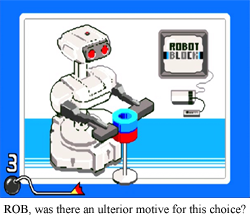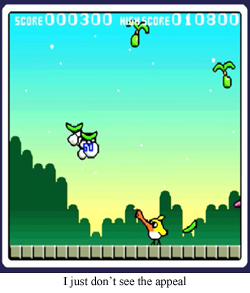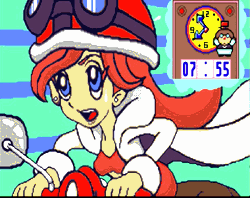 It’s interesting to see how a mythological pantheon evolves in modern times. First we have Mario, the All-Father, the head-honcho and lord of his kingdom. He may be just a plumber, but his affinity for fire and position over all others likens the jump master to Egypt’s Ra. Next, there’s the perennial “wife goddess” Princess Peach, who embodies the very concept of femininity. Luigi is an eternal “lesser brother” god, who, like Poseidon, is his own kind of king, but eternally in the shadow of one that rules the heavens. Bowser is the adversary, through and through, always battling against the forces of good and coveting and stealing any light he can find. Donkey Kong is the archetypical “bestial” aspect of man, not unlike the concept of the werewolf, as he makes a fine cart racer or banana rescuer, but God help you when the full moon comes out, and he comes to steal your women to construction sites. Even noble Yoshi draws many comparisons to the noble steeds of legendary tales, like Pegasus or Sleipnir.
It’s interesting to see how a mythological pantheon evolves in modern times. First we have Mario, the All-Father, the head-honcho and lord of his kingdom. He may be just a plumber, but his affinity for fire and position over all others likens the jump master to Egypt’s Ra. Next, there’s the perennial “wife goddess” Princess Peach, who embodies the very concept of femininity. Luigi is an eternal “lesser brother” god, who, like Poseidon, is his own kind of king, but eternally in the shadow of one that rules the heavens. Bowser is the adversary, through and through, always battling against the forces of good and coveting and stealing any light he can find. Donkey Kong is the archetypical “bestial” aspect of man, not unlike the concept of the werewolf, as he makes a fine cart racer or banana rescuer, but God help you when the full moon comes out, and he comes to steal your women to construction sites. Even noble Yoshi draws many comparisons to the noble steeds of legendary tales, like Pegasus or Sleipnir.
Nintendo has created a much fuller pantheon with its other franchises. Link is the hero, the mortal who ascends to legendary status through good deeds. Zelda is Athena, the virgin goddess of wisdom (and war) who can always be relied upon to be the smartest deity on the battlefield. It would be easy to paint Ganondorf as another demon/adversary, but his actions are more akin to that of a god of war, an ongoing source of upheaval and death, but without which there would be no need for heroes. Samus Aran has suffered an identity crisis of late, because, in her most iconic appearances, she is little more than a death goddess. Point Samus at a problem, give it two hours, and wait for the sounds of an exploding planet. A single pikachu may be nothing more than a shockrat, but Pikachu as a Nintendo/Pokémon mascot has been portrayed as a mischievous but giving friend to children, not unlike the modern interpretation of Santa Claus. And Kirby sleeps soundly in his dreamland, growing ever closer to the time when he will awake, and devour iat aftft un a hauft ur lunk. Ha ghuftft ga’uia’ uia’ ghaalunt, ang ha ghuftft fta iantsullaftfta.
But every good pantheon needs a trickster. Africa’s Anansi, the Pacific Northwest’s Raven, Navajo’s Coyote, and all sorts of gods that didn’t even appear in Disney’s Gargoyles have haunted mythologists for years with tales of deceit and guile. The most famous trickster god is likely Loki of Norse/Marvel/Disney mythology, a continual thorn in the side of Odin and Thor, generally making both of their lives miserable, but not intolerable.
 And that’s the trick with a good trickster god. Bowser the Adversary, as a good example, has become dramatically less threatening since his debut three decades ago, chiefly because his every last plan has failed spectacularly. He almost triumphed one time, and the entire universe reset just to spite him. Bowser is the bad guy, and he’s the bad guy in a medium meant to empower “the player”, so he is just never going to get anywhere. A trickster, though? A trickster can be a good trickster for centuries, as all he has to do is dupe the good guy, and, yes, the trickster will eventually be hammer-thubbed for his treachery, but he succeeded in his purpose, his trick, all the same. The good guy wins, the trickster wins, and the story is entertaining, so everybody wins.
And that’s the trick with a good trickster god. Bowser the Adversary, as a good example, has become dramatically less threatening since his debut three decades ago, chiefly because his every last plan has failed spectacularly. He almost triumphed one time, and the entire universe reset just to spite him. Bowser is the bad guy, and he’s the bad guy in a medium meant to empower “the player”, so he is just never going to get anywhere. A trickster, though? A trickster can be a good trickster for centuries, as all he has to do is dupe the good guy, and, yes, the trickster will eventually be hammer-thubbed for his treachery, but he succeeded in his purpose, his trick, all the same. The good guy wins, the trickster wins, and the story is entertaining, so everybody wins.
Given you can read the title of this article, you can probably guess that I’m building to the reveal that Wario as the trickster god of the Nintendo pantheon. And you’re right! Gold star! Though, bad news, Wario will likely steal that gold star, and now you have nothing. I apologize for the inconvenience.
Wario started as a simple rival for Mario. In his debut, Super Mario Land 2, Wario heists Mario’s entire kingdom (newsflash: Mario has a kingdom?), and Mario has to reconquer his own land. Ho-hum. Wario could have easily been the next Tatanga or Wart, but, no, he returned for a few random sports games, and then got his own series starting with Super Mario Land 3: Wario Land. The Wario Land games cemented Wario’s “greed is good” credo, but played much like any other Mario video game. After all, isn’t the auxiliary goal of any Mario game to collect as many coins and treasures and doodads as possible on your way to the goal? Is shining champion Mario that different from gluttonous anti-hero Wario? In gameplay, not at all.
 But it’s WarioWare, Inc.: Mega Microgame$! and its descendants that cements Wario as Nintendo’s trickster. The plot of WarioWare is simple: Wario wants all of the money forever, so he’s going to publish a videogame. Hey, worked for Nolan Bushnell, right? Only problem is that Wario has the video game crafting skills of Destructive Creations, so he has to round up his friends to craft his new masterpiece. Scratch that, that sounds too much like a teen movie or other such feel good story; no, Wario tricks all of his friends into creating video games for him. And that’s where the magic happens. Wario tricks you into playtesting.
But it’s WarioWare, Inc.: Mega Microgame$! and its descendants that cements Wario as Nintendo’s trickster. The plot of WarioWare is simple: Wario wants all of the money forever, so he’s going to publish a videogame. Hey, worked for Nolan Bushnell, right? Only problem is that Wario has the video game crafting skills of Destructive Creations, so he has to round up his friends to craft his new masterpiece. Scratch that, that sounds too much like a teen movie or other such feel good story; no, Wario tricks all of his friends into creating video games for him. And that’s where the magic happens. Wario tricks you into playtesting.
Make no mistake, the entirety of WarioWare is a trick. WW was released in 2003, a full five years before the launch of the Apple App Store. Relevance? Much of WarioWare is based on bite sized games that last ten seconds, max. These short, “burst” games are all the rage now, in the age of cellphones and ipads and other devices those damn kids keep playing on my lawn. 2003 was still the age of “game lasts 800 hours and is considered college credit in six states”, when the idea of games that lasted three minutes because that’s how long you’ll be in the supermarket checkout line was a long way away. And the controls of WarioWare? One button, four directions, done. Want me to name another device with one button? It’s small and rectangular and rhymes with iTyrone. Nintendo… I mean Wario… invented a genre at least half a decade before its official debut. And how does one sell such a series of games before the advent of effortless downloads and teeny pricetags? Blend them all together, call it a combined “challenge”, and slap your most devious mascot on the cover. After all, we know we have a brand new, completely unproven (but fun!) game here, if it fails, we can just laugh it off as another Wario blunder. Oh, that wacky, smelly guy.
 WarioWare has served much the same purpose since its inception: a Trojan horse to get new ideas into your head. It’s no surprise that a WarioWare game has been released with nearly every new iteration of Nintendo hardware: WW Touched introduced touch gaming and the DS microphone to anyone with the new handheld, WW Smooth Moves showed off all the weird ways you can swing your wiimote, and Game & Wario was there to showcase the myriad of new tricks available to the WiiU’s tablet. WW Snapped was even there to promote the very idea of digital download games on a portable Nintendo System, and WW D.I.Y. stands as an early attempt by Nintendo to get a “community” going, an effort that would eventually bear fruit on the WiiU and its MiiVerse. WW Twisted is a clear forerunner to Nintendo’s own decade long love affair with gyroscopic, “move sensitive” gaming.
WarioWare has served much the same purpose since its inception: a Trojan horse to get new ideas into your head. It’s no surprise that a WarioWare game has been released with nearly every new iteration of Nintendo hardware: WW Touched introduced touch gaming and the DS microphone to anyone with the new handheld, WW Smooth Moves showed off all the weird ways you can swing your wiimote, and Game & Wario was there to showcase the myriad of new tricks available to the WiiU’s tablet. WW Snapped was even there to promote the very idea of digital download games on a portable Nintendo System, and WW D.I.Y. stands as an early attempt by Nintendo to get a “community” going, an effort that would eventually bear fruit on the WiiU and its MiiVerse. WW Twisted is a clear forerunner to Nintendo’s own decade long love affair with gyroscopic, “move sensitive” gaming.
There’s a reason the Wario of WarioWare has superseded the Wario of the Wario Land franchise (and the Wario of Wario Blast: Featuring Bomberman!, which was just an early trick to get you to buy a portable Bomberman title, which you already should have been buying) in everything, from sequels to the Smash Bros. series, and that’s the simple truth that Nintendo no longer sees Wario as a platforming Mario knock-off, no, Wario is the trickster that uses his craftiness to hoodwink friends and consumers alike into testing his, and Nintendo’s, latest obsession. Smash Bros and other “party” Nintendo franchises portray Wario as a fat, weird, smelly, “off” buffoon, because who ever suspects the lout is the one swindling the masses?
Mario? Link? Pikachu? If they’re telling you there’s a new game with their face on it, what you see is what you get. They’re transparent, they’re comfortable, they are there to be trusted and worshipped, and they’ll summon you every Christmas season, and you’ll give your offering and take their blessing. Wario? Wario is the stuff stories are made of. You don’t worship Wario, but you’ll hear his tales all the same, because, when all is said and done, the good gods battling the bad gods is boring, and sometimes you just want to play with a rascal. You know the trick is coming. You know you’re being duped. But you’re going to enjoy it.
 FGC # 8 WarioWare, Inc.: Mega Microgame$!
FGC # 8 WarioWare, Inc.: Mega Microgame$!
- System: Gameboy Advance
- Number of Players: 1, though there’s a few 2 Player challenges
- Highest Score: Got 74 on Dribble and Spitz’s challenges. I don’t even remember liking those games…
- What’s with Nintendo associating “gross” with “experimental”? I don’t know, but it sure worked great for Earthbound!
- Did You Know? Waluigi has never appeared in a WarioWare game, though he is considered by Smash Bros to be part of the Wario Universe. This is likely an indicator that the Mushroom Kingdom wants nothing to do with Waluigi, a sentiment shared by most anyone that has ever encountered that freak. Waluigi: a man without a country.
- Would I Play Again? I’m lucky (gullible) enough to be a member of the 3DS Ambassador Program, so I have WarioWare, Inc.: Mega Microgame$! permanently loaded onto my most portable gaming system. This likely makes this the first FGC game that I play frequently, albeit randomly. It’s not so much a matter of playing again, as I’ve never stopped.
What’s Next? Random ROB has chosen… Donkey Kong Country. Huh, guess ROB is on a kick thinking about his parent company. Bananas abound, everyone, please look forward to it!
[…] not only as my miscellaneous category (which I try to avoid indulging too much) for games like Wario Ware, but also games that are compilations of wildly disparate games, like Sonic the Hedgehog […]
[…] full stop. It is a “classic” Wario game, which means, as opposed to a Wario presiding over a minigame marathon, this Wario is an action platforming hero. Well, “hero”. And, while I think Wario, minister of […]
[…] WarioWare turned those opinions around in one tight/bonkers experience. Fresh on the heels of the previous WarioWare, Wario returned with more silly microgames meant to get the player using that stylus, microphone, […]
[…] This is Wario’s first appearance, and, while he is clearly the antagonist, he is still very much Wario. Is he kidnapping princesses or threatening the state of the world? No, he’s just a homeless dude […]